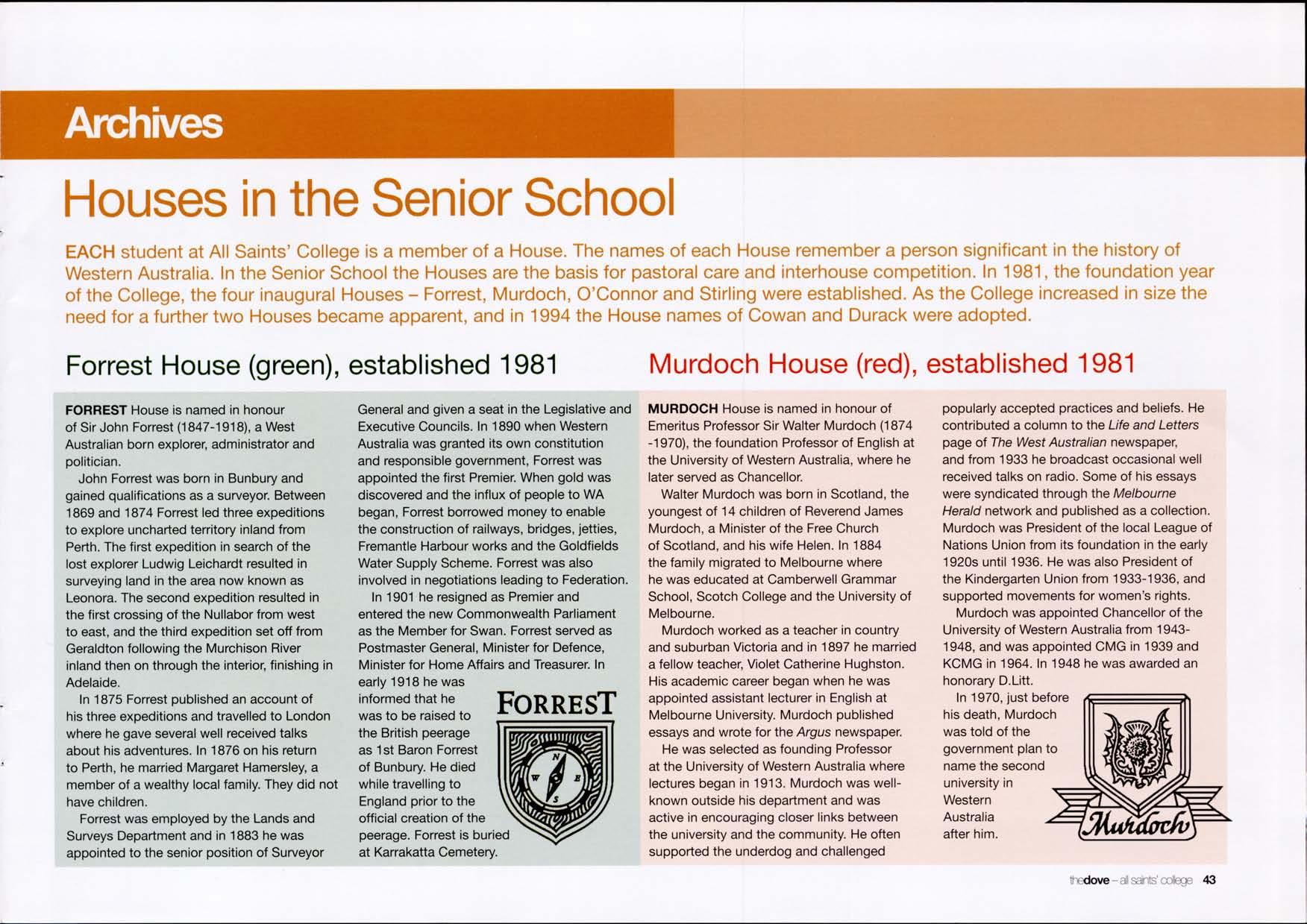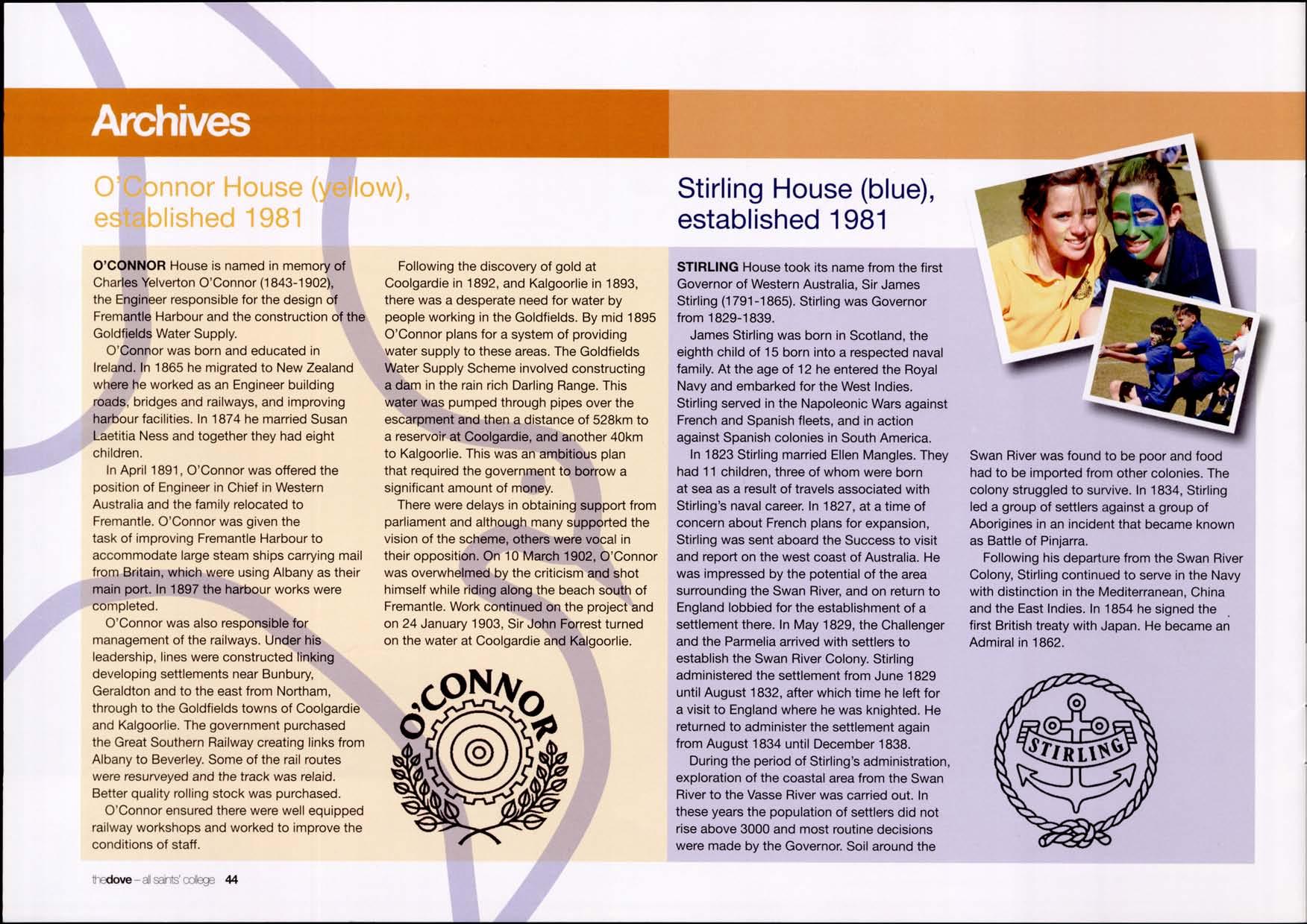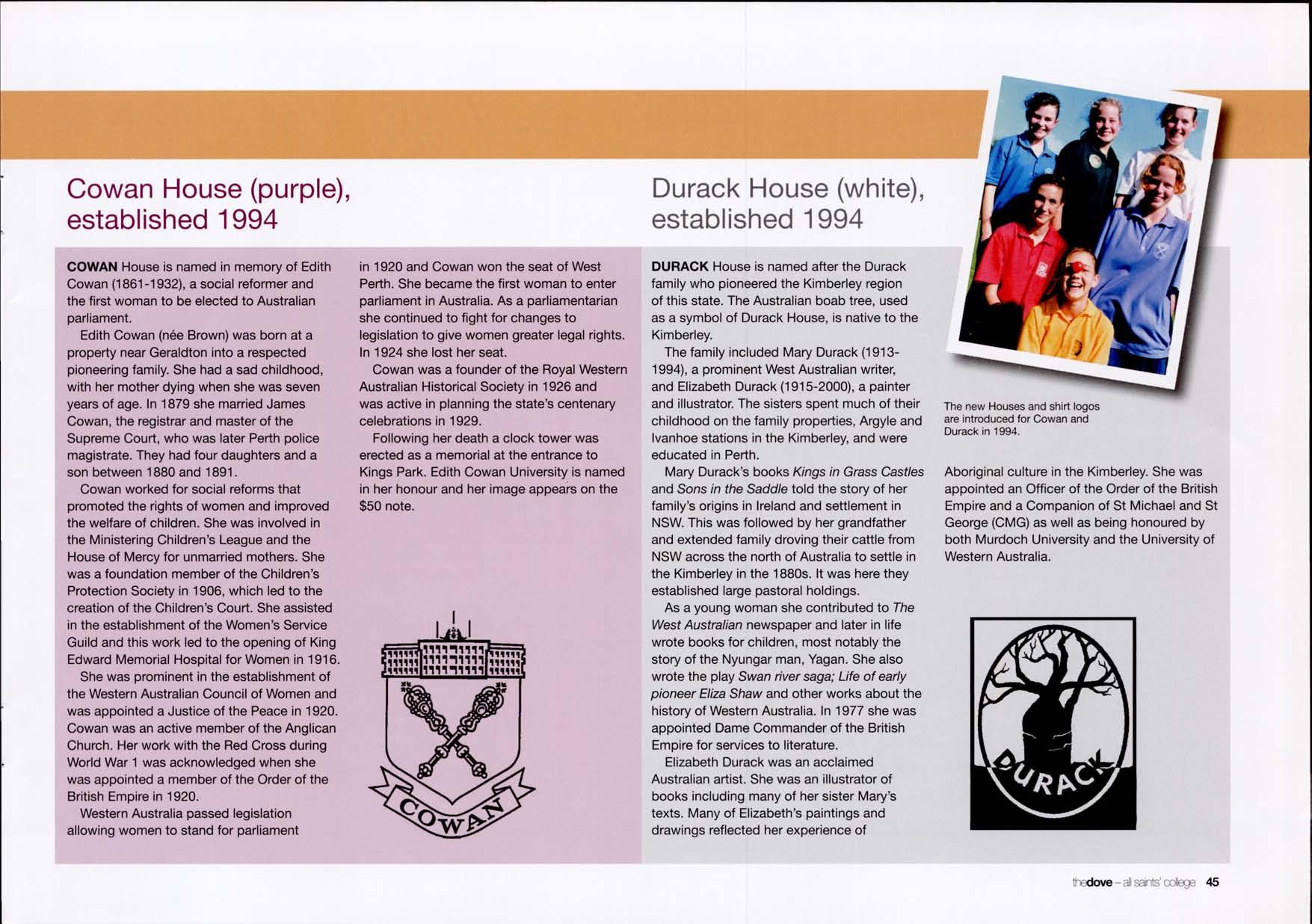
10 minute read
From the Archives A history of Senior School House names
Archives
, Houses in the Senior School
EACH student at All Saints' College is a member of a House. The names of each House remember a person significant in the history of Western Australia. In the Senior School the Houses are the basis for pastoral care and interhouse competition. In 1981, the foundation year of the College, the four inaugural Houses - Forrest, Murdoch, O'Connor and Stirling were established. As the College increased in size the need for a further two Houses became apparent, and in 1994 the House names of Cowan and Durack were adopted.
Forrest House (green), established 1981
FORREST House is named in honour of Sir John Forrest (1847-1918), a West Australian born explorer, administrator and politician.
John Forrest was born in Bunbury and gained qualifications as a surveyor. Between 1869 and 1874 Forrest led three expeditions to explore uncharted territory inland from Perth. The first expedition in search of the lost explorer Ludwig Leichardt resulted in surveying land in the area now known as Leonora. The second expedition resulted in the first crossing of the Nullabor from west to east, and the third expedition set off from Geraldton following the Murchison River inland then on through the interior, finishing in Adelaide.
In 1875 Forrest published an account of his three expeditions and travelled to London where he gave several well received talks about his adventures. In 1876 on his return to Perth, he married Margaret Hamersley, a member of a wealthy local family. They did not have children.
Forrest was employed by the Lands and Surveys Department and in 1883 he was appointed to the senior position of Surveyor General and given a seat in the Legislative and Executive Councils. In 1890 when Western Australia was granted its own constitution and responsible government, Forrest was appointed the first Premier. When gold was discovered and the influx of people to WA began, Forrest borrowed money to enable the construction of railways, bridges, jetties, Fremantle Harbour works and the Goldfields Water Supply Scheme. Forrest was also involved in negotiations leading to Federation.
In 1901 he resigned as Premier and entered the new Commonwealth Parliament as the Member for Swan. Forrest served as Postmaster General, Minister for Defence, Minister for Home Affairs and Treasurer. In early 1918 he was informed that he FORREST was to be raised to the British peerage as 1st Baron Forrest of Bunbury. He died while travelling to England prior to the official creation of the peerage. Forrest is buried at Karrakatta Cemetery.
Murdoch House (red), established 1981
MURDOCH House is named in honour of Emeritus Professor Sir Waiter Murdoch (1874 -1970), the foundation Professor of English at the University of Western Australia, where he later served as Chancellor.
Waiter Murdoch was born in Scotland, the youngest of 14 children of Reverend James Murdoch, a Minister of the Free Church of Scotland, and his wife Helen. In 1884 the family migrated to Melbourne where he was educated at Camberwell Grammar School, Scotch College and the University of Melbourne.
Murdoch worked as a teacher in country and suburban Victoria and in 1897 he married a fellow teacher, Violet Catherine Hughston. His academic career began when he was appointed assistant lecturer in English at Melbourne University. Murdoch published essays and wrote for the Argus newspaper.
He was selected as founding Professor at the University of Western Australia where lectures began in 1913. Murdoch was wellknown outside his department and was active in encouraging closer links between the university and the community. He often supported the underdog and challenged popularly accepted practices and beliefs. He contributed a column to the Life and Letters page of The West Australian newspaper, and from 1933 he broadcast occasional well received talks on radio. Some of his essays were syndicated through the Melbourne Herald network and published as a collection. Murdoch was President of the local League of Nations Union from its foundation in the early 1920s until 1936. He was also President of the Kindergarten Union from 1933-1936, and supported movements for women's rights.
Murdoch was appointed Chancellor of the University of Western Australia from 19431948, and was appointed CMG in 1939 and KCMG in 1964. In 1948 he was awarded an honorary D.Litt.
In 1970, just before his death, Murdoch was told of the government plan to name the second university in Western Australia after him.
o e
n or House ( bl"shed 981 low),
O'CONNOR House is named in memory of Charles Yelverton O'Connor (1843-1902), the Engineer responsible for the design of Fremantle Harbour and the construction of the Goldfields Water Supply.
O'Connor was born and educated in Ireland. In 1865 he migrated to New Zealand where he worked as an Engineer building roads, bridges and railways, and improving harbour facilities. In 1874 he married Susan Laetitia Ness and together they had eight children.
In April 1891 , O'Connor was offered the position of Engineer in Chief in Western Australia and the family relocated to Fremantle. O'Connor was given the task of improving Fremantle Harbour to accommodate large steam ships carrying mail from Britain, which were using Albany as their main port. In 1897 the harbour works were completed.
O'Connor was also responsible for management of the railways. Under his leadership, lines were constructed linking developing settlements near Bunbury, Geraldton and to the east from Northam, through to the Goldfields towns of Coolgardie and Kalgoorlie. The government purchased the Great Southern Railway creating links from Albany to Beverley. Some of the rail routes were resurveyed and the track was relaid. Better quality rolling stock was purchased.
O'Connor ensured there were well equipped railway workshops and worked to improve the conditions of staff.
Following the discovery of gold at Coolgardie in 1892, and Kalgoorlie in 1893, there was a desperate need for water by people working in the Goldfields. By mid 1895 O'Connor plans for a system of providing water supply to these areas. The Goldfields Water Supply Scheme involved constructing a dam in the rain rich Darling Range. This water was pumped through pipes over the escarpment and then a distance of 528km to a reservoir at Coolgardie, and another 40km to Kalgoorlie. This was an ambitious plan that required the government to borrow a significant amount of money.
There were delays in obtaining support from parliament and although many supported the vision of the scheme, others were vocal in their opposition. On 10 March 1902, O'Connor was overwhelmed by the criticism and shot himself while riding along the beach south of Fremantle. Work continued on the project and on 24 January 1903, Sir John Forrest turned on the water at Coolgardie and Kalgoorlie.

Stirling House (blue), established 1981
STIRLING House took its name from the first Governor of Western Australia, Sir James Stirling (1791-1865). Stirling was Governor from 1829-1839.
James Stirling was born in Scotland, the eighth child of 15 born into a respected naval family. At the age of 12 he entered the Royal Navy and embarked for the West Indies. Stirling served in the Napoleonic Wars against French and Spanish fleets, and in action against Spanish colonies in South America.
In 1823 Stirling married EIIen Mangles. They had 11 children, three of whom were born at sea as a result of travels associated with Stirling's naval career. In 1827, at a time of concern about French plans for expansion, Stirling was sent aboard the Success to visit and report on the west coast of Australia. He was impressed by the potential of the area surrounding the Swan River, and on return to England lobbied for the establishment of a settlement there. In May 1829, the Challenger and the Parmelia arrived with settlers to establish the Swan River Colony. Stirling administered the settlement from June 1829 until August 1832, after which time he left for a visit to England where he was knighted. He returned to administer the settlement again from August 1834 until December 1838.
During the period of Stirling's administration, exploration of the coastal area from the Swan River to the Vasse River was carried out. In these years the population of settlers did not rise above 3000 and most routine decisions were made by the Governor. Soil around the Swan River was found to be poor and food had to be imported from other colonies. The colony struggled to survive. In 1834, Stirling led a group of settlers against a group of Aborigines in an incident that became known as Battle of Pinjarra.
Following his departure from the Swan River Colony, Stirling continued to serve in the Navy with distinction in the Mediterranean, China and the East Indies. In 1854 he signed the . first British treaty with Japan. He became an Admiral in 1862.
Cowan House (purple), established 1994
COWAN House is named in memory of Edith Cowan (1861-1932), a social reformer and the first woman to be elected to Australian parliament.
Edith Cowan (nee Brown) was born at a property near Geraldton into a respected pioneering family. She had a sad childhood, with her mother dying when she was seven years of age. In 1879 she married James Cowan, the registrar and master of the Supreme Court, who was later Perth police magistrate. They had four daughters and a son between 1880 and 1891.
Cowan worked for social reforms that promoted the rights of women and improved the welfare of children. She was involved in the Ministering Children's League and the House of Mercy for unmarried mothers. She was a foundation member of the Children's Protection Society in 1906, which led to the creation of the Children's Court. She assisted in the establishment of the Women's Service Guild and this work led to the opening of King Edward Memorial Hospital for Women in 1916.
She was prominent in the establishment of the Western Australian Council of Women and was appointed a Justice of the Peace in 1920. Cowan was an active member of the Anglican Church. Her work with the Red Cross during World War 1 was acknowledged when she was appointed a member of the Order of the British Empire in 1920.
Western Australia passed legislation allowing women to stand for parliament in 1920 and Cowan won the seat of West Perth. She became the first woman to enter parliament in Australia. As a parliamentarian she continued to fight for changes to legislation to give women greater legal rights. In 1924 she lost her seat.
Cowan was a founder of the Royal Western Australian Historical Society in 1926 and was active in planning the state's centenary celebrations in 1929.
Following her death a clock tower was erected as a memorial at the entrance to Kings Park. Edith Cowan University is named in her honour and her image appears on the $50 note.
Durack House (white), established 1994
DURACK House is named after the Durack family who pioneered the Kimberley region of this state. The Australian boab tree, used as a symbol of Durack House, is native to the Kimberley.
The family included Mary Durack (19131994), a prominent West Australian writer, and Elizabeth Durack (1915-2000), a painter and illustrator. The sisters spent much of their childhood on the family properties, Argyle and lvanhoe stations in the Kimberley, and were educated in Perth.
Mary Durack's books Kings in Grass Castles and Sons in the Saddle told the story of her family's origins in Ireland and settlement in NSW. This was followed by her grandfather and extended family droving their cattle from NSW across the north of Australia to settle in the Kimberley in the 1880s. It was here they established large pastoral holdings.
As a young woman she contributed to The West Australian newspaper and later in life wrote books for children, most notably the story of the Nyungar man, Yagan. She also wrote the play Swan river saga; Life of early pioneer Eliza Shaw and other works about the history of Western Australia. In 1977 she was appointed Dame Commander of the British Empire for services to literature.
Elizabeth Durack was an acclaimed Australian artist. She was an illustrator of books including many of her sister Mary's texts. Many of Elizabeth's paintings and drawings reflected her experience of

The new Houses and shirt logos are introduced for Cowan and Durack in 1994.
Aboriginal culture in the Kimberley. She was appointed an Officer of the Order of the British Empire and a Companion of St Michael and St George (CMG) as well as being honoured by both Murdoch University and the University of Western Australia.










